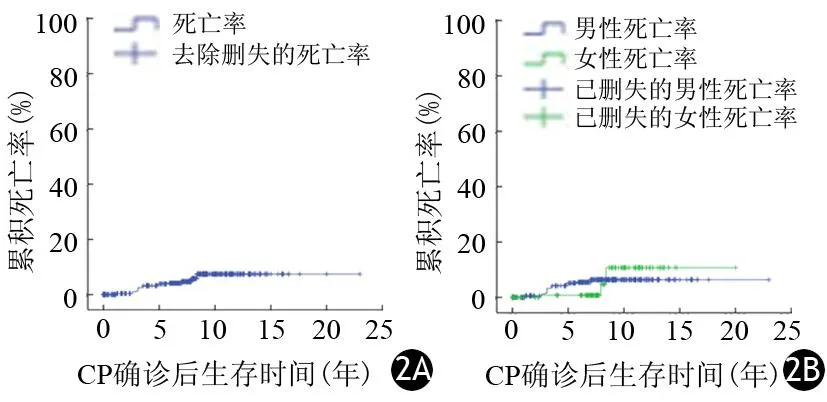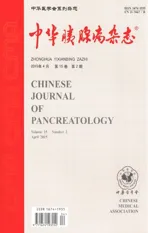慢性胰腺炎死亡及其危险因素分析
2016-01-11夏天,杜婷婷,李白容等
·论著·
慢性胰腺炎死亡及其危险因素分析
夏天杜婷婷李白容胡良皞廖专郑兆泓叶博季钧淘王丹林金欢陈辉李兆申
【摘要】目的探讨慢性胰腺炎(CP)患者生存情况、死亡原因及其危险因素。方法收集2000年1月至2008年12月上海长海医院住院的CP患者资料,寿命表法计算死亡的累积发生率,死亡的危险因素采用Cox比例风险模型逐步回归分析。结果591例CP患者中男女比例为2.69∶1,随访率为85.6%,平均观察时间(10.6±6.3)年。共30例(5.1%)患者死亡,排除2例意外或死因不详者,28例患者的死亡中位年龄为62岁,与发病时间间隔8.2年。CP发病后1、5、10年的死亡累积发生率为0、2.18%、6.86%;CP确诊后1、5、10年的死亡累积发生率为0、4.14%、7.44%,男女之间死亡率差异无统计学意义(P=0.956)。通过单因素分析筛选出7个变量纳入Cox比例风险模型,得出CP确诊前伴有脂肪泻(OR值为5.780)及酗酒(OR值为4.524)为其死亡危险因素。结论CP确诊前已伴有脂肪泻或酗酒的CP患者更易出现死亡。
【关键词】胰腺炎,慢性;死亡率;危险因素
DOI:10.3760/cma.j.issn.1674-1935.2015.02.005
收稿日期:(2015-01-17)
Risk factors of mortality in patients with chronic pancreatitisXiaTian,DuTingting,LiBairong,HuLianghao,LiaoZhuang,ZhengZhaohong,YeBo,JiJuntao,WangDan,LinJinhuan,ChenHui,LiZhaoshen.DepartmentofGastroenterology,ChanghaiHospital,SecondMilitaryMedicalUniversity,Shanghai200433,China
Correspondingauthor:LiZhaoshen,Email:zhaoshen-li@hotmail.com
Abstract【】ObjectiveTo investigate the survival, causes of death and risk factors of death in CP patients. MethodsA retrospective study was conducted on CP patients admitted in Changhai Hospital from January 2000 to December 2008. The life table method was used to estimate the cumulative death rate. Cox proportional hazard model was used for multivariate analysis of the risk factors. ResultsThere were 591 patients, and the male/female ratio was 2.69, the followed up rate was 85.6%, and the patients were followed for an average of 10.6±6.3 years. A total of 30 patients died, and 2 patients were died of accident or unknown reasons, in the remaining 28 patients, the median age of 62 years old, and the interval between the onset/diagnosis of CP and death was 8.2 years. The cumulative incidence of death were 0, 2.18%, 6.86%, 0, 4.14% and 7.44%, respectively, at 1 year, 5 years and 10 years after CP onset and CP diagnosis, respectively, without significant gender difference (p=0.956). Seven variables derived from univariate analysis were involved in the multivariate analysis by the Cox proportional hazards regression model, and it showed that steatorrhea before CP diagnosis (OR5.780) and excessive drinking (OR4.524) were the risk factors of death in CP patients. ConclusionsCP patients with steatorrhea or alcoholics before CP diagnosis have higher risk of death.
【Key words】Pancreatitis, chronic;Mortality;Risk factors
慢性胰腺炎(chronic pancreatitis, CP)患者病程中常常出现脂肪泻、糖尿病等营养代谢障碍,这可能会增加营养相关性疾病风险;部分CP患者在病程晚期可出现胰源性门脉高压,这一因素可增加该部分患者消化道出血风险;另外,CP与胰腺癌的发生密切相关[1-2]。既往研究发现,CP患者的死亡风险远高于正常人群,包括肿瘤死亡、心血管事件死亡及其他病因死亡均显著增高[3-7]。本研究以长海医院消化科CP临床数据库为基础,总结CP患者死亡病因、分析死亡相关危险因素,以期增加对CP临床病程尤其是临床结局的认识。

作者单位:200433上海,第二军医大学长海医院消化内科
通信作者:李兆申,Email: zhaoshen-li@hotmail.com
资料和方法
一、研究对象
纳入标准:2000年1月至2008年12月在长海医院住院治疗符合CP诊断标准的患者。排除标准:为了减少胰腺癌患者被误诊为CP,本研究排除了CP确诊与胰腺癌变间隔小于2年的病例。自身免疫性胰腺炎及沟槽状胰腺炎为CP的特殊类型,但由于其临床表现、诊断及预后与常见的CP存在差异,故未将其纳入该研究。
二、诊断标准
1.CP诊断标准:(1)典型的临床表现(反复发作上腹痛或急性胰腺炎等);(2)影像学检查提示胰腺钙化、胰管结石、胰管狭窄或扩张等;(3)病理学有特征性改变;(4)有胰腺内外分泌功能不全表现。具备(2)或(3)可确诊;具备(1)和(4)为拟诊[8]。
2.酒精性CP诊断标准:男性酒精摄入量大于80 g/d,持续时间大于2年;女性酒精摄入量大于60 g/d,持续时间大于2年[9-10]。
3.遗传性CP诊断标准:两代或两代以上,一级亲属中有2人,二级亲属中有3人或3人以上存在复发性胰腺炎或慢性胰腺炎[11]。
三、研究方法
详细记录患者发病情况及入院后实验室、影像学检查结果及治疗经过,并建议其出院后1年内来院复诊。对于未及时来院复诊的患者,通过电话或书信的方式随访患者在此期间的病情变化及相关治疗。对于在研究期间死亡的患者,详细记录其死亡时间及死亡原因。本研究中主要探讨CP对患者死亡率的影响,而心血管疾病死亡的患者,其死亡原因是否与CP的代谢异常相关,尚不明确,故也将这部分患者纳入研究,只排除那些死因不明或者意外死亡的患者。
所有患者均以CP发病为观察起点,以最后一次随访、失访、死亡时间为观察终点。
四、统计学处理
采用SPSS18.0统计学软件,计量资料采用studentt检验或Mann-WhitneyU检验,非正态分布时采用秩和检验;计数资料分析采用χ2检验或Fisher精确法;所有检验均为双侧检验。其中癌变的累积发病率采用Kaplan-Meier法。在CP死亡的危险因素分析中,以CP确诊后时间为时间依赖协变量,建立Cox风险回归模型,单因素强制进回归模型,P<0.25的因素纳入多因素分析。P<0.05具有统计学意义。
结 果
一、一般情况
2000年1月至2008年12月共591例CP患者入长海医院消化内科治疗,男女比例2.69∶1,失访85人,随访率为85.6%,平均观察时间(10.6±6.3)年。患者的CP发病年龄及确诊年龄分别为(42±16)岁和(45±16)岁,青少年(<18岁)CP 67例。591例CP患者的病因中特发性CP 496例,酒精性CP 76例,遗传性CP 2例,解剖异常17例。
二、死亡患者情况
591例患者中30例(5.1%)死亡,其中男性22例,女性8例。死亡原因:胰腺癌13例(43.3%),消化道出血6例(20.0%),梗阻性黄疸1例(3.3%),非胰腺疾病8例(26.7%),意外或原因不详2例(6.7%)。本研究排除2例意外或原因不详死亡患者,共纳入589例患者的基本信息。28例死亡患者CP发病年龄为(55±14)岁,死亡中位年龄62岁,发病至死亡中位时间8.2年,确诊至死亡中位时间3.5年。死亡患者的发病年龄较未死亡患者发病年龄晚,差异有统计学意义(P=0.000)。CP发病后1、5、10年的累积死亡率为0、2.18%、6.86%,男女之间差异无统计学意义(P=0.869,图1);CP确诊后1、5、10年的累积死亡率为0、4.14%、7.44%,男女之间差异无统计学意义(P=0.956,图2)。
三、Cox风险比例模型回归分析
结合CP病程中相关因素,在单因素分析中共纳入20个变量(表1),分析后得出患者的发病年龄、青少年、确诊年龄、酗酒、确诊前有无糖尿病、脂肪泻及胆管狭窄等项因素的P值<0.25,纳入多因素Cox风险比例模型(表1)。为避免变量重叠所致干扰,分析时将青少年发病年龄纳入发病年龄这一变量。结果显示酗酒、CP确诊前有脂肪泻为CP患者死亡的独立危险因素。
讨 论
各研究中心的CP患者病因不同,随访时间长短不一,造成各研究得出的死亡率不同。本研究结果显示,CP发病后5、10年的累积死亡率为2.18%和6.86%,CP确诊后5年和10年的累积死亡率为4.14%和7.44%,死亡原因主要为CP并发胰腺癌及消化道出血,约三分之一死亡的CP患者为心血管等其他非胰源性死亡,但这些死亡病因很可能与CP相关的营养代谢异常有关。 通过对死亡相关危险因素的分析,发现酒精性CP患者死亡风险高。Anderson等[12]一项研究显示CP患者肿瘤发生风险与饮酒显著相关,且有随着饮酒量的增加,肿瘤风险随之增加。Lankisch等[13]报道,虽然戒酒对疼痛的缓解帮助不大,但是可以降低CP患者的死亡率,所以应该提倡CP患者戒酒。而丹麦的大型全国多中性CP研究结果显示,酗酒和吸烟均不会增加癌变率和死亡率[3],这与本课题组既往已确认吸烟史癌变的独立危险因素的结论不一致[12,14-16]。这可能是此研究基于全国医疗登记系统、对吸烟饮酒情况的评估存在较大偏倚有关。另外,本研究未将被误诊为CP的胰腺癌病例剔除。

图1 CP患者(1A)及男、女性(1B)患者发病后的累积死亡率

图2 CP患者(1A)及男、女性(1B)患者确诊后的累积死亡率
脂肪泻可增加CP患者死亡的风险。胰腺组织进行性、不可逆的纤维化是CP重要特点,随着病情的进展,胰腺功能、尤其是外分泌功能损害不可避免。胰腺外分泌功能不全(pancreatic exocrine insufficiency,PEI)的发生率为42%~99%,与CP的病程阶段有关[17-21]。既往研究发现,CP患者出现PEI将增加不成熟动脉粥样硬化、心血管事件、骨质疏松、骨折、免疫相关性疾病及感染性疾病等发生风险[22-24]。PEI可导致碳水化合物、蛋白质、脂肪及脂溶性物质的吸收障碍[25-26],可增加包括营养不良、代谢相关性心血管病变的风险,从而导致CP死亡风险高于正常人群。

表1 CP死亡危险因素分析
注:a与腹痛比较
但本研究存在局限性。首先,纳入研究的CP患者死亡例数仅为30例,对CP死因总结及其危险因素的分析可能存在偏倚,更长的随访时间及多中心纳入更多CP例数可增加研究结果的可信度。另外,CP患者的病情进展与其他系统并发疾病可能存在相互作用,与CP患者的死亡关系密切,本研究主要对CP确诊前病程中的临床特点及临床事件进行死亡危险因素的筛查,未纳入所有潜在危险因素,研究结果可能存在偏倚。
参考文献
[1]Kudo Y, Kamisawa T, Anjiki H, et al. Incidence of and risk factors for developing pancreatic cancer in patients with chronic pancreatitis[J]. Hepatogastroenterology, 2011,58(106):609-611.
[2]Pezzilli R, Morselii Labate AM, Fantini L, et al. Quality of life and clinical indicators for chronic pancreatitis patients in a 2-year follow-up study[J]. Pancreas, 2007,34(2):191-196.
[3]Bang UC, Benfield T, Hyldstrup L, et al. Mortality, cancer, and comorbidities associated with chronic pancreatitis: a Danish nationwide matched-cohort study[J]. Gastroenterology, 2014,146(4):989-994.
[4]Seicean A, Tantau M, Grigorescu M, et al. Mortality risk factors in chronic pancreatitis[J]. J Gastrointestin Liver Dis, 2006,15(1):21-26.
[5]Rebours V, Boutron-Ruault MC, Jooste V, et al. Mortality rate and risk factors in patients with hereditary pancreatitis: uni- and multidimensional analyses[J]. Am J Gastroenterol, 2009,104:2312-2317.
[6]Nøjgaard C, Bendtsen F, Becker U, et al. Danish patients with chronic pancreatitis have a four-fold higher mortality rate than the Danish population[J]. Clin Gastroenterol Hepatol, 2010,8(4):384-390.
[7]Thuluvath PJ, Imperio D, Nair S, et al. Chronic pancreatitis. Long-term pain relief with or without surgery, cancer risk, and mortality[J]. J Clin Gastroenterol, 2003,36(2):159-165.
[8]《中华胰腺病杂志》编委会,中华医学会消化内镜学分会. 慢性胰腺炎诊治指南(2012, 上海)[J]. 中华胰腺病杂志, 2012,12(3):208-210.
[9]Wang W, Guo Y, Liao Z, et al. Occurrence of and risk factors for diabetes mellitus in Chinese patients with chronic pancreatitis[J]. Pancreas, 2011,40(2):206-212.
[10]Witt H, Sahin-Tóth M, Landt O, et al. A degradation-sensitive anionic trypsinogen (PRSS2) variant protects against chronic pancreatitis[J]. Nat Genet, 2006,38(6):668-673.
[11]Howes N, Lerch MM, Greenhalf W, et al. Clinical and genetic characteristics of hereditary pancreatitis in Europe[J]. Clin Gastroenterol Hepatol, 2004,2(3):252-261.
[12]Anderson MA, Zolotarevsky E, Cooper KL, et al. Alcohol and tobacco lower the age of presentation in sporadic pancreatic cancer in a dose-dependent manner: a multicenter study[J]. Am J Gastroenterol, 2012,107(11):1730-1739.
[13]Lankisch P, Banks P. Pancreatitis[M]. Berlin, Heidelberg: Springer-Verlag, 1998.
[14]Brand RE, Greer JB, Zolotarevsky E, et al. Pancreatic cancer patients who smoke and drink are diagnosed at younger ages[J]. Clin Gastroenterol Hepatol, 2009,7(9):1007-1012.
[15]Talamini G, Bassi C, Falconi M, et al. Alcohol and smoking as risk factors in chronic pancreatitis and pancreatic cancer[J]. Dig Dis Sci, 1999,44(7):1303-1311.
[16]Ji BT, Chow WH, Dai Q, et al. Cigarette smoking and alcohol consumption and the risk of pancreatic cancer: a case-control study in Shanghai, China[J]. Cancer Causes Control, 1995,6(4):369-376.
[17]Layer P, Yamamoto H, Kalthoff L, et al. The different courses of early- and late-onset idiopathic and alcoholic chronic pancreatitis[J]. Gastroenterology, 1994,107(5):1481-1487.
[18]Ammann RW, Akovbiantz A, Largiader F, et al. Course and outcome of chronic pancreatitis. Longitudinal study of a mixed medical-surgical series of 245 patients[J]. Gastroenterology, 1984,86(5 Pt1):820-828.
[19]Braganza JM, Hunt LP, Warwick F. Relationship between pancreatic exocrine function and ductal morphology in chronic pancreatitis[J]. Gastroenterology, 1982,82(6):1341-1347.
[20]Lankisch MR, Imoto M, Layer P, et al. editors. The effect of small amounts of alcohol on the clinical course of chronic pancreatitis[J]. Mayo Clin Proc, 2001,76(3):242-251.
[21]Ammann RW, Buehler H, Muench R, et al. Differences in the (Nonalcoholic) and Natural History of Idiopathic Alcoholic Chronic Pancreatitis. A comparative long-term study of 287 patients[J]. Pancreas, 1987,2(4):368-377.
[22]Pongprasobchai S. Maldigestion from pancreatic exocrine insufficiency[J]. J Gastroenterol Hepatol, 2013,28(Suppl 4):99-102.
[23]Montalto G, Soresi M, Carroccio A, et al. Lipoproteins and chronic pancreatitis[J]. Pancreas, 1994,9(1):137-138.
[24]Tignor AS, Wu BU, Whitlock TL, et al. High prevalence of low-trauma fracture in chronic pancreatitis[J]. Am J Gastroenterol, 2010,105(12):2680-2686.
[25]Dominguez-Munoz JE, Iglesias-Garcia J, Vilarino-Insua M, et al. 13C-mixed triglyceride breath test to assess oral enzyme substitution therapy in patients with chronic pancreatitis[J]. Clin Gastroenterol Hepatol, 2007,5(4):484-488.
(本文编辑:屠振兴)
